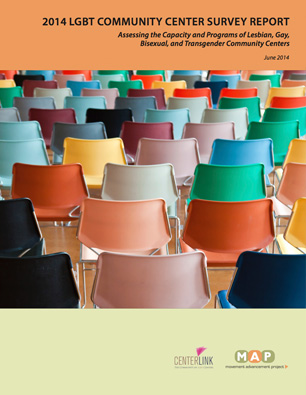The Bottom Line
The biennial LGBT Community Center Survey Report provides a detailed picture of centers’ staffs and boards, program priorities, constituencies and services, infrastructure, fundraising, budgets, and technical assistance needs. The 2014 report finds that local community centers serving lesbian, gay, bisexual, and transgender people provide vital information, education, and health services to almost 40,000 people each week.
- 2014 LGBT Community Center Survey Report Download
- 2014 LGBT Community Center Survey Report: CyberCenters Download
- 2012 LGBT Community Center Survey Report Download
- 2010 LGBT Community Center Survey Report Download
- 2008 LGBT Community Center Survey Report Download
Abstract
The LGBT Community Center Survey Report, prepared jointly by MAP and CenterLink and published every two years, provides an overview of local lesbian, gay, bisexual, and transgender (LGBT) community centers, including their capacity, their programs and services, the people they serve, and their technical assistance needs.
The 2014 report analyzes data from 111 LGBT community centers, which represent 84% of all LGBT community center expenses. Among the report’s key findings:
- LGBT community centers serve almost 40,000 people each week (or over 1.9 million people annually). This includes referring over 9,900 people weekly to other organizations or agencies for services and assistance.
- Both large and small LGBT centers reported revenues increases from 2012 to 2013; small centers experienced a 20% increase in revenues from 2012 to 2013, compared to a 12% increase for large centers.
- Despite the increase in average center revenue, many centers still struggle with a lack of funding and resources; 21% of all surveyed centers have no staff and rely solely on volunteers; and 57% have five or fewer paid staff. Almost half of center staff (49%) identify as people of color.
- The demographics of LGBT community center patrons vary greatly among centers. On average however, center patrons are disproportionately male, people of color, transgender, and/or low-income.



